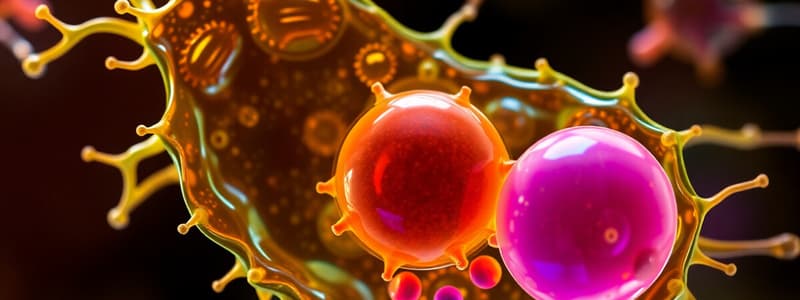Podcast
Questions and Answers
What is the primary function of integrins in the plasma membrane?
What is the primary function of integrins in the plasma membrane?
- To regulate osmotic pressure
- To store genetic information
- To facilitate cellular respiration
- To bind glycoproteins of the extracellular matrix (correct)
Which component is found in the primary cell wall of plant cells?
Which component is found in the primary cell wall of plant cells?
- Cellulose
- Pectin (correct)
- Chitin
- Lignin
What happens to the primary cell wall after a plant cell stops elongating?
What happens to the primary cell wall after a plant cell stops elongating?
- It becomes more flexible
- It disintegrates completely
- It gets replaced by the secondary cell wall (correct)
- It is stained for observation
What is the role of the middle lamella in plant cells?
What is the role of the middle lamella in plant cells?
Which statement is true regarding the secondary cell wall in plant cells?
Which statement is true regarding the secondary cell wall in plant cells?
What is the primary process by which chloroplasts convert light energy?
What is the primary process by which chloroplasts convert light energy?
What is the role of the inner mitochondrial membrane?
What is the role of the inner mitochondrial membrane?
What type of pigment does chlorophyll primarily consist of?
What type of pigment does chlorophyll primarily consist of?
What are the folded membranes within mitochondria known as?
What are the folded membranes within mitochondria known as?
Which of the following statements is true regarding apoptosis?
Which of the following statements is true regarding apoptosis?
What kind of organelles are plastids?
What kind of organelles are plastids?
What molecules do chloroplasts produce from carbon dioxide and water?
What molecules do chloroplasts produce from carbon dioxide and water?
What are cytochrome c's primary functions in the cell?
What are cytochrome c's primary functions in the cell?
What happens when mitochondria leak electrons?
What happens when mitochondria leak electrons?
What structure encloses the thylakoid lumen in a chloroplast?
What structure encloses the thylakoid lumen in a chloroplast?
What is the primary function of the plasma membrane in a cell?
What is the primary function of the plasma membrane in a cell?
Which of the following statements correctly describes ribosomes?
Which of the following statements correctly describes ribosomes?
What characteristic distinguishes prokaryotic cells from eukaryotic cells?
What characteristic distinguishes prokaryotic cells from eukaryotic cells?
What is the role of lysosomes in a cell?
What is the role of lysosomes in a cell?
How do eukaryotic cells maintain diverse cellular functions?
How do eukaryotic cells maintain diverse cellular functions?
What does the Golgi complex primarily do?
What does the Golgi complex primarily do?
Which is a function of the endoplasmic reticulum?
Which is a function of the endoplasmic reticulum?
What is the structure of the nucleus primarily responsible for regulating?
What is the structure of the nucleus primarily responsible for regulating?
Which type of microscope provides the highest resolution for studying cell ultrastructure?
Which type of microscope provides the highest resolution for studying cell ultrastructure?
What is the primary role of peroxisomes in a cell?
What is the primary role of peroxisomes in a cell?
How do mitochondria and chloroplasts contribute to cellular energy?
How do mitochondria and chloroplasts contribute to cellular energy?
What best describes the function of vacuoles in plant cells?
What best describes the function of vacuoles in plant cells?
What is the primary purpose of the cell theory?
What is the primary purpose of the cell theory?
What is the primary structural component of cilia and flagella in eukaryotic cells?
What is the primary structural component of cilia and flagella in eukaryotic cells?
What is the role of kinesin in the cell?
What is the role of kinesin in the cell?
Which statement about intermediate filaments is correct?
Which statement about intermediate filaments is correct?
What role do microtubule-associated proteins (MAPs) play in cells?
What role do microtubule-associated proteins (MAPs) play in cells?
Which of the following best describes the structure of microtubules?
Which of the following best describes the structure of microtubules?
Which cellular component is involved in the movement of chromosomes during cell division?
Which cellular component is involved in the movement of chromosomes during cell division?
What mechanism do microfilaments use to generate movement?
What mechanism do microfilaments use to generate movement?
What is the significance of the glycocalyx surrounding cells?
What is the significance of the glycocalyx surrounding cells?
Centrosomes are primarily responsible for which function during cell division?
Centrosomes are primarily responsible for which function during cell division?
How do dynein proteins contribute to cellular function?
How do dynein proteins contribute to cellular function?
What is the primary role of the extracellular matrix in animal cells?
What is the primary role of the extracellular matrix in animal cells?
Which structural feature is characteristic of the basal body anchoring cilia and flagella?
Which structural feature is characteristic of the basal body anchoring cilia and flagella?
What is the diameter range of microfilaments in eukaryotic cells?
What is the diameter range of microfilaments in eukaryotic cells?
Flashcards are hidden until you start studying
Study Notes
Integrin Function
- Integrins are transmembrane proteins that act as cell adhesion receptors, connecting the extracellular matrix to the cytoskeleton within a cell.
Primary Cell Wall Composition
- Cellulose is the primary component of the primary cell wall in plant cells.
Primary Cell Wall Changes
- The primary cell wall becomes thicker and more rigid after a plant cell stops elongating.
Middle Lamella Role
- The middle lamella acts as a glue-like layer between adjacent plant cells, holding them together and providing structural support.
Secondary Cell Wall Properties
- The secondary cell wall is a thicker and more rigid layer that forms inside the primary cell wall in some plant cells, providing strength and support.
Chloroplast Energy Conversion
- The primary process by which chloroplasts convert light energy is photosynthesis.
Inner Mitochondrial Membrane Function
- The inner mitochondrial membrane is the site of ATP production through oxidative phosphorylation, the final stage of cellular respiration.
Chlorophyll Pigment
- Chlorophyll primarily consists of a green pigment that absorbs light energy for photosynthesis.
Mitochondrial Folded Membranes
- The folded membranes within mitochondria are called cristae, increasing the surface area for ATP production.
Apoptosis Characteristics
- Apoptosis is a programmed cell death process that involves a series of biochemical events leading to cell shrinkage, DNA fragmentation, and ultimately, cell death.
Plastid Organelle Classification
- Plastids are a group of organelles found in plant cells and some algae, including chloroplasts, chromoplasts, and leucoplasts.
Chloroplast Products
- Chloroplasts produce glucose (sugar) from carbon dioxide and water via photosynthesis.
Cytochrome c Functions
- Cytochrome c is a protein involved in electron transport within the mitochondria and plays a crucial role in both cellular respiration and apoptosis.
Mitochondrial Electron Leakage
- When mitochondria leak electrons, it can lead to oxidative stress and damage to cellular components, potentially contributing to aging and diseases.
Thylakoid Lumen Enclosure
- The thylakoid lumen, the internal space within the thylakoid membrane, is enclosed by the thylakoid membrane itself, which is a network of interconnected flattened sacs within the chloroplast.
Plasma Membrane Function
- The plasma membrane serves as a selective barrier that regulates the passage of molecules into and out of the cell, maintaining cellular homeostasis.
Ribosome Description
- Ribosomes are complex molecular machines responsible for protein synthesis, composed of ribosomal RNA (rRNA) and proteins.
Prokaryotic vs. Eukaryotic Distinction
- The absence of a true nucleus and other membrane-bound organelles distinguishes prokaryotic cells from eukaryotic cells.
Lysosome Function
- Lysosomes act as the cell's recycling centers, breaking down waste materials, cellular debris, and ingested substances.
Eukaryotic Cellular Function Maintenance
- Eukaryotic cells maintain diverse cellular functions through compartmentalization, where different organelles are specialized for different tasks, creating a division of labor.
Golgi Complex Role
- The Golgi complex acts as a processing and packaging center for proteins and lipids, modifying and sorting them for transport to their destinations.
Endoplasmic Reticulum Function
- The endoplasmic reticulum plays a role in protein synthesis, protein folding, lipid synthesis, and detoxification.
Nucleus Regulation
- The nuclear envelope, the membrane surrounding the nucleus, primarily regulates the movement of molecules between the nucleus and the cytoplasm.
Highest Resolution Microscopy
- Electron microscopes, specifically transmission electron microscopes (TEM), provide the highest resolution for studying cell ultrastructure.
Peroxisome Role
- Peroxisomes are involved in various metabolic reactions, including the breakdown of fatty acids, detoxification of harmful substances, and the synthesis of certain lipids.
Mitochondria & Chloroplast Energy Contribution
- Mitochondria and chloroplasts are the primary energy factories of the cell. Mitochondria generate ATP through cellular respiration, while chloroplasts produce glucose through photosynthesis.
Plant Vacuole Function
- Vacuoles in plant cells serve as storage compartments for water, nutrients, pigments, and waste products, also playing a role in maintaining turgor pressure and cell shape.
Cell Theory Purpose
- The cell theory states that all living organisms are composed of cells and that cells arise from pre-existing cells. This theory laid the foundation for our understanding of life and its organization.
Cilia & Flagella Structural Component
- Microtubules, specifically arranged in a 9+2 arrangement, are the primary structural component of cilia and flagella.
Kinesin Role
- Kinesin is a motor protein that moves along microtubule tracks, transporting vesicles, organelles, and other cellular cargo within the cell.
Intermediate Filament Characteristics
- Intermediate filaments are a diverse group of rope-like protein fibers that provide structural support and help maintain cell shape, resisting tension and anchoring organelles.
MAP Function
- Microtubule-associated proteins (MAPs) regulate microtubule assembly, stability, and interactions with other cellular components, affecting their function and dynamics.
Microtubule Structure
- Microtubules are hollow cylindrical structures composed of α- and β-tubulin protein dimers, forming long strands of protofilaments that assemble into a tube.
Chromosome Movement Component
- Microtubules are involved in the movement of chromosomes during cell division, attaching to chromosomes and pulling them apart to ensure equal distribution of genetic material.
Microfilament Movement Mechanism
- Microfilaments, composed of actin protein, generate movement through interactions with motor proteins like myosin. This interaction causes the filaments to slide past each other, resulting in muscle contraction or other forms of cellular movement.
Glycocalyx Significance
- The glycocalyx, a layer of carbohydrates surrounding the cell membrane, plays a role in cell recognition, adhesion, protection, and signaling.
Centrosome Function During Cell Division
- Centrosomes, composed of two centrioles, are responsible for organizing microtubules, forming the mitotic spindle during cell division, which is crucial for chromosome segregation.
Dynein Protein Contribution
- Dynein proteins are motor proteins that move along microtubules, contributing to the sliding of microtubules within cilia and flagella, facilitating movement of these structures.
Extracellular Matrix Role
- The extracellular matrix (ECM) in animal cells provides structural support, regulates cell behavior, and facilitates communication between cells.
Basal Body Feature
- The basal body, a structure that anchors cilia and flagella, is characterized by a 9+0 arrangement of microtubules, similar to the structure of centrioles within centrosomes.
Microfilament Diameter Range
- Microfilaments in eukaryotic cells have a diameter range of 5-9 nanometers.
Studying That Suits You
Use AI to generate personalized quizzes and flashcards to suit your learning preferences.




